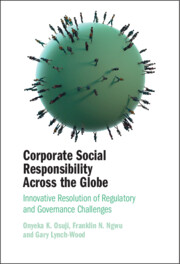 Corporate Social Responsibility Across the Globe
Corporate Social Responsibility Across the Globe Book contents
- Corporate Social Responsibility Across the Globe
- Corporate Social Responsibility Across the Globe
- Copyright page
- Epigraph
- Contents
- Figures
- Table of Cases
- Table of Legislation
- 1 Introduction: The Centrality of Regulation in Corporate Responsibility
- Part I Regulation Concepts, Paradigms and Approaches for Corporate Social Responsibility
- 2 The Values System Paradigm As a Regulatory Alternative to Stakeholder Needs CSR
- 3 Incentives, Public Procurement and Market Mechanisms
- 4 Governance of Firms, Poverty and Shared Responsibilities for Human Rights in UNGPs: Smart-Mix Regulation and CSR within Coalitions of the (Un)Willing
- Part II Infusing Corporate Social Responsibility in Corporate Governance
- Part III Stimulating Private Regulation of Corporate Social Responsibility
- References
4 - Governance of Firms, Poverty and Shared Responsibilities for Human Rights in UNGPs: Smart-Mix Regulation and CSR within Coalitions of the (Un)Willing
from Part I - Regulation Concepts, Paradigms and Approaches for Corporate Social Responsibility
Published online by Cambridge University Press: 15 June 2023
- Corporate Social Responsibility Across the Globe
- Corporate Social Responsibility Across the Globe
- Copyright page
- Epigraph
- Contents
- Figures
- Table of Cases
- Table of Legislation
- 1 Introduction: The Centrality of Regulation in Corporate Responsibility
- Part I Regulation Concepts, Paradigms and Approaches for Corporate Social Responsibility
- 2 The Values System Paradigm As a Regulatory Alternative to Stakeholder Needs CSR
- 3 Incentives, Public Procurement and Market Mechanisms
- 4 Governance of Firms, Poverty and Shared Responsibilities for Human Rights in UNGPs: Smart-Mix Regulation and CSR within Coalitions of the (Un)Willing
- Part II Infusing Corporate Social Responsibility in Corporate Governance
- Part III Stimulating Private Regulation of Corporate Social Responsibility
- References
Summary
The chapter uses global poverty as a case study subset of human rights to expand the smart-mix regulation discourse to the field of human rights where there is little legal affirmation of the methods for tackling challenges. It shows how the UN Guiding Principles on Business and Human Rights (UNGPs) exemplify governance reluctance and uncertainties in international human rights law. It argues that, if properly designed, corporate social responsibility (CSR) can potentially address governance gaps for human rights beyond the scope of the UNGPs. The chapter further shows that CSR can be utilised by willing actors for safeguarding rights and combating the unwillingness of powerful political and economic entities to accept the legalisation of business responsibility for human rights.
Keywords
- Type
- Chapter
- Information
- Corporate Social Responsibility Across the GlobeInnovative Resolution of Regulatory and Governance Challenges, pp. 65 - 96Publisher: Cambridge University PressPrint publication year: 2023
